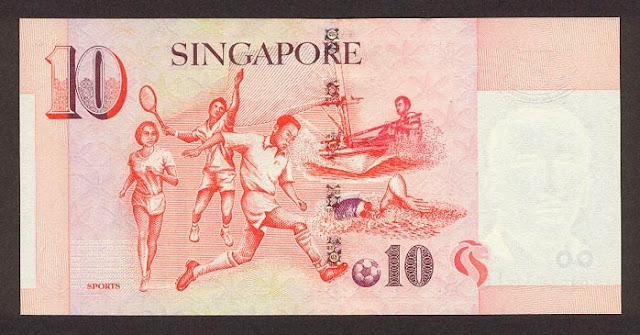 |
| Singapore Portrait Series currency notes - $10 banknote |
Singapore banknotes 10 Dollars banknote Portrait Series 1999–present
Singapore dollar, Singapore banknotes, Singapore paper money, Singapore bank notes, Singapore dollar bills - world banknotes money currency pictures gallery.Obverse: Portrait of Singapore's first President, Yusof bin Ishak.
The note also shows the Wandering Cowrie (Cypraea errones Linnaeus, 1758). A variable member of the genus, this species is difficult to describe but easy to recognise by the mottled green top with a large, brownish and centrally located blotch. This blotch may vary in shape and size from specimen to specimen.
The cowrie's size range is between 13 and 43 mm. Having an Indo-West Pacific distribution, this animal is a shallow-water resident, found at the inter-tidal zone and down to a few metres below mean low tide level. Although its numbers have declined in Singapore, it still remains the most common cowrie here.
The Sports Theme is reflected in the $10 note through the depiction of five popular sports pursuits. On the back of the note, we see a jogger, a tennis player and a soccer player on one side, representing the most favoured land sports in Singapore. On the other side, swimming and sailing are pictured representing water sports. These are illustrated against a vibrant general design to convey the sense of energy and ruggedness symbolising sporting activities in general.
Colour: Red
Size of note: 141mm x 69 mm
First issued on: 9 September 1999 (Paper), 4 May 2004 (Polymer)
4th Series – Singapore Portrait Series currency notes 1999–present
The current Portrait series was introduced in 1999, with the one- and 500-dollar denominations omitted. These notes feature the face of Yusof bin Ishak, the first president of the Republic of Singapore, on the obverse, and the reverse depicts a feature of civic virtue. There are both paper and polymer notes in circulation. The designs of the polymer notes are very similar to the corresponding paper note except for the slightly slippery feel and a small transparent window design in the corner of the banknote. Polymer notes are progressively replacing the paper banknotes in circulation. The notes also have Braille patterns at the top right-hand corner of the front design.